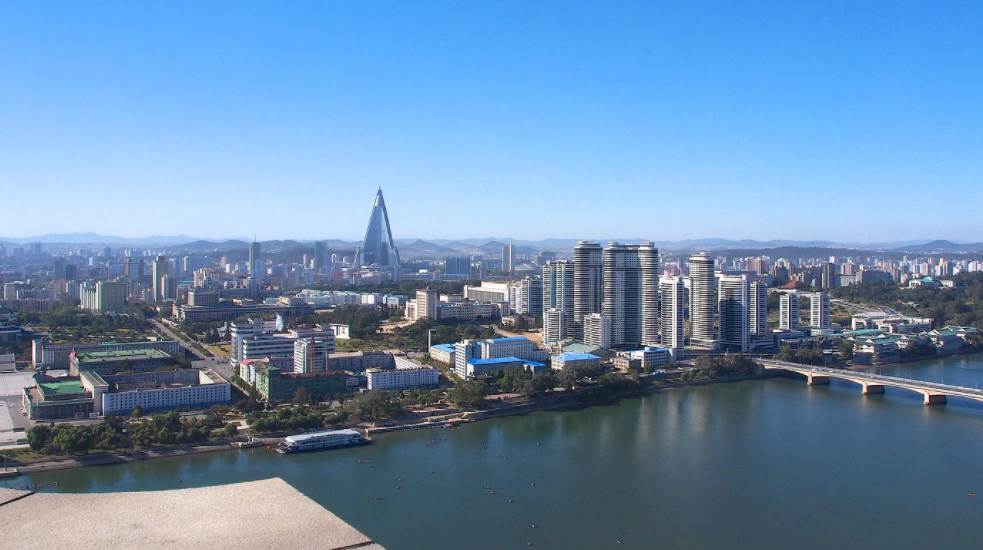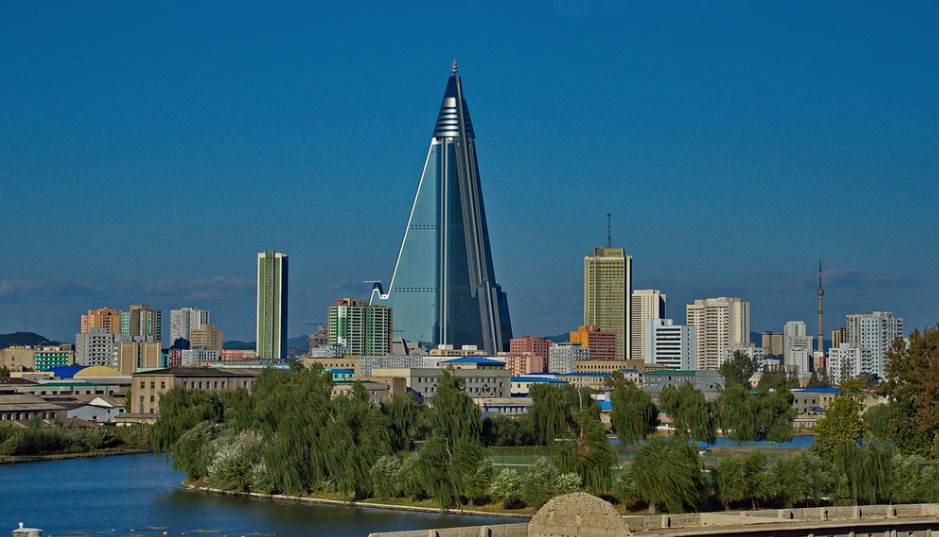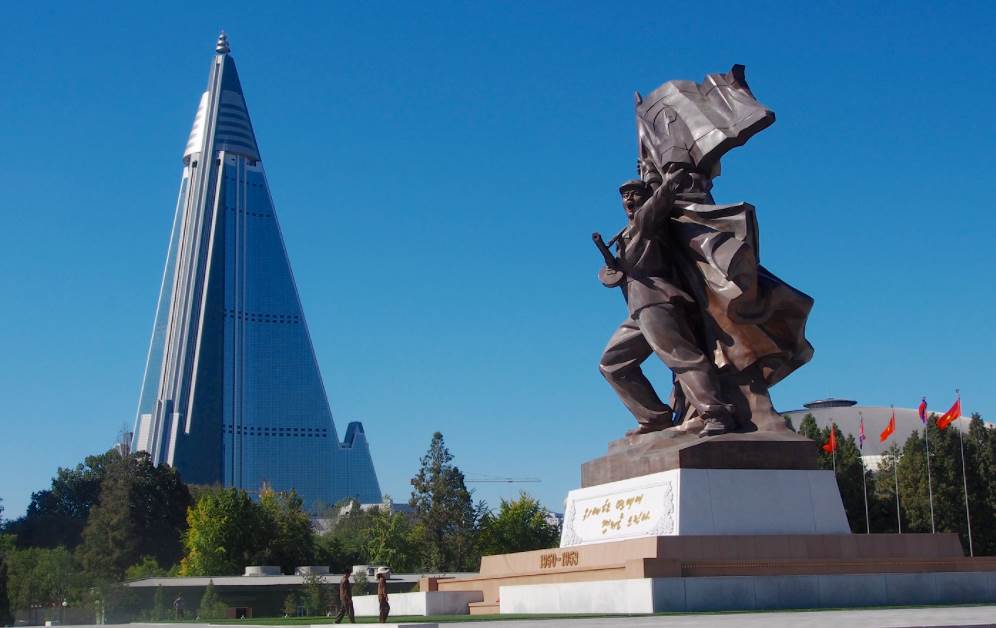The only city in the world where you’ll find an enormous magnificent skyscraper that is completely unoccupied is Pyongyang, the capital of North Korea.
Let’s take a closer look at some of the most interesting facts about the Ryogyong Hotel, an amazing structure that stands out among the dilapidated Soviet-style apartment blocks in this strange place.
1. It’s located just northwest of the center of Pyongyang
The Ryugyong Hotel is arguably one of the most peculiar buildings in the world. It’s located in the northwestern section of the large city of Pyongyang, the mysterious capital of North Korea.
The pyramid-shaped and futuristic structure dominates the city’s skyline as it’s located just a few kilometers northwest of Kim Il Sung Square, the most important square in the city which can be described as the city’s historical heart.
Other famous landmarks in the area are the Pyongyang Arena, a large indoor venue, and Rungra Island isn’t too far away to the east as well. This island on the Taedong River is the home of what is presumably the largest stadium in the world, the Rungrado 1st of May Stadium.

2. The building was named after the historical name of the city
The Ryugyong Hotel translates to the “Capital of Willows Hotel.” This name was derived from one of the many historical names of the city.
Other former names of the city include Kisong, Hwangsong, Rakrang, Sŏgyong, Sodo, Hogyong, Changan, and also Heijō during Japanese rule in Korean between 1910 and 1945.
The building itself is also sometimes referred to as the “Ryu-Gyong Hotel,” the “Yu-Kyung Hotel,” or the “105 Building,” a reference to the number of floors the building has.
3. It’s the tallest building in North Korea and held a remarkable record
The tip of this pyramid-shaped structure stands exactly 330.02 meters (1,082.7 feet) above the ground below and would be a remarkable skyscraper in just about any city in the world. This height also makes it by far the tallest structure in North Korea.
The second and third-tallest structures in the country are two relatively new condominium buildings known as Ryomyong Condominiums 1 and 2 and stand 270 meters (890 feet) and 240 meters (790 feet) tall respectively.
According to Guinness World Records, it was the tallest unoccupied building in the world for an extended period. This dubious record was taken over by the Goldin Finance 117 tower in Tianjin China, an unfinished skyscraper with an incredible height of 596.5 meters (1,957 feet) that topped out in 2015.

4. The construction started in the 1980s for a particular reason
Every major building and monument in Pyongyang has been built to glorify the current regime in North Korea. The Juche Tower glorifies the ideology of the country, and the Arch of Triumph was built in honor of the birthday of the Great Leader, to name just a few of these remarkable structures.
This makes it no surprise that the Ryugyong Hotel was commissioned to emphasize the perceived greatness of the leadership in the country. The main reason it was built was to become the tallest hotel in the world a record set by the Westin Stamford Hotel in Singapore in 1986.
This hotel is today known as the “Swissôtel The Stamford” and stands 226 meters (741 feet) tall. To beat the height of this hotel in Singapore during the Cold War period, the construction of the Ryugyong Hotel started on August 28, 1987.
If the deadline had been met in the year 1992, it would have held the record as the tallest hotel in the world as well, but the construction was halted due to financial problems following the Fall of the Soviet Union in the early 1990s.
5. The exterior was completed in 2011 but it’s still far from finished
The building topped out in 1992 but it was still far from finished and couldn’t serve as a hotel back then. The roughly finished building didn’t have windows yet and its construction was halted for over a decade.
Out of nowhere, the construction was resumed in April 2008 when a $400 million deal was reached between the North Korean government and an Egyptian telecommunication company named the “Orascom Group.”
The North Korean government announced that the building would be completed by 2012. This was the year of the 100th birthday of the so-called “Eternal President Kim Il-Sung,” a man whose remains are at display at the Kumsusan Palace of the Sun a few kilometers to the northeast of the building.
It eventually turned out that the Egyptian company only integrated the exterior glass panels of the building and installed an antenna as part of a larger 3G cellular telecommunications deal. Although the exterior of the building makes it look as if it’s completed, the interior still shows no sign of the hotel opening any time soon.

More interesting facts about the Ryugyong Hotel
6. The pyramidal-shaped building has a fascinating architectural design, to say the least. It consists of 3 wings that are each about 100 meters (330 feet) long and 18 meters (59 feet) wide. The estimated floor area of the building is an astounding 360,000 square meters (3,900,000 square feet).
The walls of the building slope at an angle of 75 degrees and come together near the top which features a cone that has a width of 40 meters (130 feet). This section features 8 floors that are intended to rotate and feature revolving restaurants.
7. The North Korean government lured foreign investors at the start of the project by promising them the opportunity to house a casino, nightclubs, and various other entertainment facilities inside the building with no oversight from the regime.
The goal was to raise $230 million this way and they surely were able to convince a few investors. A North Korean company called Baikdoosan Architects & Engineers was created who started working on the building in 1987. How much they eventually got remains unknown.

8. The construction cost was most probably much higher than the amount the government tried to raise. Japanese newspapers reported that the building would cost at least $750 million to complete in the early 1990s, something that never happened.
The structure has been referred to by many derogatory names throughout its history, including the “Hotel of Doom,” and “Phantom Hotel.” It was also referred to by the media as “The worst building in the history of mankind,” mainly because of its unfinished state.
9. The building received such bad press in foreign media that its existence was even denied by the North Korean government throughout the 16 years that its construction was halted.
They went to great lengths for this because they photoshopped images to remove the building and excluded it from maps that were sold to North Koreans. This was a clear case of a propaganda attempt backfiring and scrambling to cover it up.

10. Although the Egyptian company that refurbished the exterior of the building denied that it was commissioned to complete the building, there have been brief signs of life at the construction site.
International hotel operator Kempinski once announced they would operate the hotel in 2012 but backed out in 2013 stating that “market entry is not possible at the moment.”
A LED display featuring the North Korean flag was added to the top of the building in April 2018 and it covered an entire side of the building just a few months later. A banner was added above the hotel’s entrance bearing its name in June 2019.
Does this mean that the Ryingyong Hotel will soon open for business? Our guess is a simple no, this will remain one of the most peculiar buildings in the world until the current regime in North Korea is removed.



